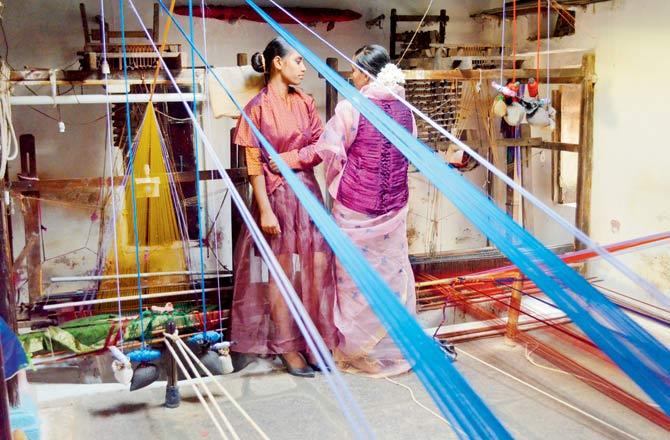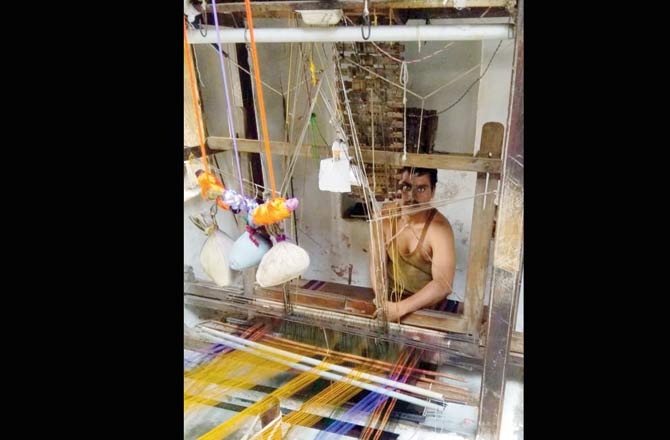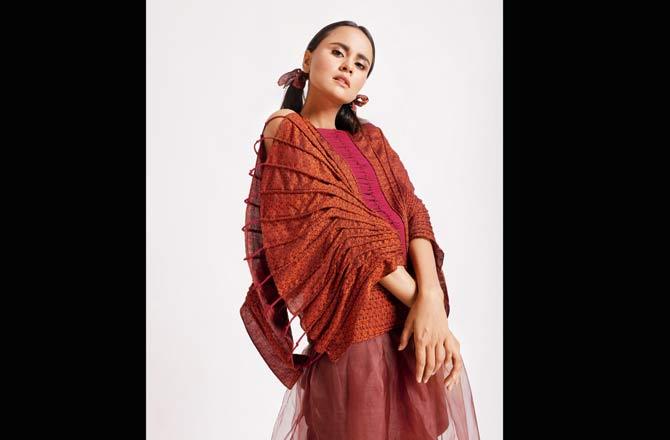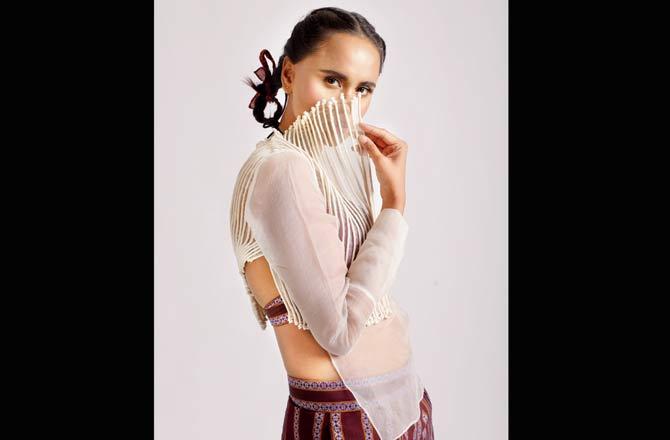A Bandra designer sparks sustainability change in a Karnataka town to revive a 'choli' fabric that's wowing audiences at global fashion weeks

Khun romper with corded top from Umber line shown at New York Fashion Week
Every adult in the Keludi family works the looms. They begin at 9 am until sundown. With each stroke, the fabric begins to take shape, motifs coming to life, and bright colours streaking the greys of the walls in vibgyor. At the end of six days, the yarn that stretches from the warp beam to the heddle come together in a tapestry that no one except the weavers could've imagined. On the seventh day, they rest.
ADVERTISEMENT
Rajshekhar Keludi was 15 when his father introduced him to weaving. He's 39 now and one of the few weavers in Guledgudda, Karnataka, who runs hand-run looms that create a fabric called khunn or khund. By his account, there are close to 50 khunn handlooms in the town. There used to be more a few years ago, 400 or so.

Pit looms in the homes of Guledgudda weavers where local women pose in khunn blouses designed by Vaishali Shadangule. Typically, khunn used the standard green, yellow, blue and magenta. Now, weavers have expanded their colour palette to include whites, peacock blue and different shades of red
Weaving khunn is the only thing he has ever done and will likely ever do, like his father did before him. But Keludi refuses to let his children follow suit. It's impossible now to hand-weave khunn for a living and easier to mass-produce it on a power loom. That way you manufacture more and make more money. But you also lose something—that singular unbroken thread that links you to your forefathers. That's all right, Keludi says; you do what's required to survive.
In 2012, a resident of Mumbai came knocking on Keludi's door wanting to buy hand-woven khunn. He brought out his wares, but she called him out. The motifs weren't intricate, the cloth was synthetic. Keludi's mother scolded him; grudgingly, he brought out the real deal. It was the end of Vaishali Shadangule's quest that had taken her from Mumbai to Pune, Kolhapur, Solapur and Bagalkot, before someone pointed her to the Guledgudda. It was also the beginning of a journey that would see the Mumbai designer weave herself into the khunn weaving landscape.

Rajshekhar Keludi is one of the first handloom weavers to collabore with Vaishali Shadangule
Khunn is a cotton and silk weave that's native to northern Karnataka and Maharashtra. It is manufactured, almost exclusively, in Guledgudda and typically worn as a saree blouse. On the map, Guledgudda is four hours away from the textile hub of Ichalkaranji and one hour from the saree hub of Ilkal. In reality, you are likely to drive past and not know it exists. Yet, you'd have likely seen its creations—those colourful blouses your vegetable vendor wears, the blouse-skirt young girls in Maharashtra sport or the triangular folded fabric pieces you unthinkingly offer to the family goddess on an annual pilgrimage, just like Shadangule once had.
"It's a brocade weave that's not very different from Banarasi, except it's a lot less famous. Khun is lightweight, has a fall, is soft, and a lot more affordable," she says. "It comes in bright metallic colours and carries motifs of the Badami fort and faces of goddesses." The origins of khunn remain something of a mystery, but since it's sturdy and affordable, it's popular with the working class. It costs about R350 a metre and, typically, women will wear one blouse with five sarees given that it's a riot of shades. "There are different versions of how the fabric got its name, but the likeliest one is that it comes from khund, the unit of measurement [equivalent to half a metre]," Shadangule explains.

Corded khun cape worn over a sheer silk skirt
"The blouse my veggie vendor was wearing was almost hypnotic. Over the years, during my travels to rural Maharashtra, I kept coming across the fabric in different colours, all impossible to miss. In 2012, I launched my first line featuring khunn. I followed it up with another in 2013 and 2015." The weavers that work with Shadangule use cotton yarn, and a mix of cotton and silk.
It seemed to her that khunn was finally getting its time in the sun. Except it was having a curious side effect. When she landed in Guledgudda in 2018, she learnt that the number of hand-run looms had fallen to 40; the power looms had shot up to 500. "In a week, they produce 12 metres of fabric on one handloom. On a power loom, they make 150 metres," she says. It was a no-brainer.

Asymmetrical sheer top with cording and bead details layered over khun bralette and paired with striped khunn pants
According to a 2017 study published in the Asian Journal of Home Science, more than half of the weaver families in Guledgudda make less than R20,000 a month after having put in 12 hours of work a day. "The money crunch is so severe that several of the younger lot look for jobs in Bagalkot and Bengaluru. Sometimes for as little as R5,000," says Shadangule. Keludi says it takes R300 per day to survive in Guledgudda. As many as 2,000 people travel every day from Guledgudda to nearby Bagalkot to make just as much money. "If we're able to make that much here, we wouldn't go outside to work."
Then, there's the matter of starting a family. "People refuse to marry their daughters into weavers' families because of how little they earn." Keludi says he found his wife only after he was able to convince his in-laws that he also made fabric on power looms.

Vaishali Shadangule
When Shadangule met Keludi again in 2018, she urged him to rally others in Guledgudda who owned handlooms. Since the fabric isn't expensive to begin with, Shadangule could afford to buy the entire stock. "I've used khunn in clothes, accessories and even home decor products," she says about the range that's priced at R6000 upwards and available at her Perry Cross Road store, and online.
That same year, she happened to hear spiritual guru Jaggi Vasudev's interview with Imran Amed, founder of The Business of Fashion. Here, he spoke about how no one was working on khunn. She reached out to Isha Foundation, Vasudev's non-profit, and showed his team the work she had done. It was the beginning of a collaboration. All Isha Foundation stores now stock her pieces made from handloom-made khunn. In the summer of 1997, Shadangule left her home in Vidisha, Madhya Pradesh. She was a little over 18. She landed in Mumbai and started doing odd jobs at garment factories and local gyms.
At some point, she discovered she had an eye for design and enrolled for a course in fashion technology. Once she had a portfolio, she began sharing it with the female clients who visited the gym. In 2001, she set up a boutique in Malad with an initial investment of R50,000 and there was no looking back. She often draws inspiration from the time gone by and her roots. For her first Lakmé Fashion Week line at the Winter-Festive 2012 season, Shadangule drew into her childhood memories and used motifs of boats and paper planes.
Gradually, Vaishali S Studio and its sustainble fashion efforts have gathered followers. Actor-author Lisa Ray wore her cowl neck drape dress to the Radiant Wellness Conclave in Chennai. Last month, she took khunn to the global stage when her range was shown at the New York and Milan fashion weeks. The line was called Bisra or the forgotten one. But, taking something that's essentially rural to international shores comes with its own challenges. "Earlier, the dyes were chemical-based and would bleed. So, that had to be fixed. And since the fabric is used for blouses, the width was traditionally 35 inches. To create larger garments, even a pair of shorts, I needed the width changed to 45 plus. So there is a lot of wastage," she explains.
In the coming months, Shadangule is looking to set up wider looms and a central organic dyeing unit to streamline the logistics. Along with Keludi, Vaishali is also organising the handloom weavers into a society. "Besides buying the fabric from them, we plan to help the weavers with design intervention, development and marketing. They will get to keep 70 per cent of the profits," she promises.
The weaver community has also evolved. Having found an assured buyer, they are gradually opening up to experimenting. "Earlier, we made the fabric in five colours, now we're making it in 10," says Keludi, who gets his silk yarn from Rayadurga and Doddapura in Karnataka. That his lot is moving from chemical-based dyes to organic ones has helped reduce ailments arising from constant exposure to chemicals. Keludi says he made 15 per cent higher profits this year than he did in 2018. And, yes, he's eager to form the society, but the issues that have plagued Guledgudda persist. Young women and men are still leaving the town for marginally better prospects and power looms continue to churn synthetic khunn. This isn't the champagne-popping end you may have been expecting. But it's a start. At the moment, there are 40 handlooms in Guledgudda still clacking. That's 40 more than zero.
12m
Amount of fabric woven on handloom in one week
150m
Amount made on powerloom in one week
Catch up on all the latest Mumbai news, crime news, current affairs, and also a complete guide on Mumbai from food to things to do and events across the city here. Also download the new mid-day Android and iOS apps to get latest updates
 Subscribe today by clicking the link and stay updated with the latest news!" Click here!
Subscribe today by clicking the link and stay updated with the latest news!" Click here!







